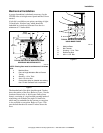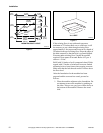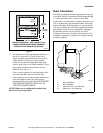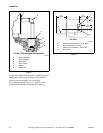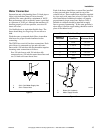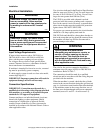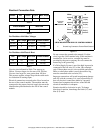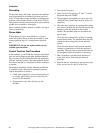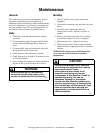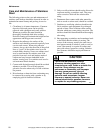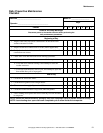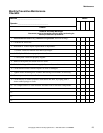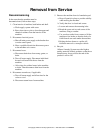
Maintenance
F232158
20
© Copyright, Alliance Laundry Systems LLC – DO NOT COPY or TRANSMIT
Care and Maintenance of Stainless
Steel
The following points on the care and maintenance of
stainless steel surfaces should be observed in order to
maintain the natural beauty and prolong its service
life.
1. Cleanliness is of utmost importance. Common
deposits of dirt and grease can be quickly
removed with a detergent and water solution.
Whenever possible, the metal should be
thoroughly rinsed and dried after washing.
Periodic cleaning will maintain the bright surface
appearance and help prevent corrosion.
2. Deposits that adhere to the surface of the
stainless steel should be removed especially from
crevices and corners. When using abrasive
cleaners, always rub in the direction of the polish
lines or “grain” of the stainless steel to avoid
scratch marks showing. Never use ordinary steel
wool or steel brushes on stainless steel. Iron
particles from steel wool and brushes made of
carbon steel may become imbedded in the
surface, causing rust. Use stainless steel wool or
soft non-metal bristle brushes.
3. Contact with dissimilar metals should be avoided
whenever possible. This will help prevent
galvanic corrosion when salty or acidic solutions
are present.
4. Discolorations or heat tint from overheating may
be removed by scouring with a powder or by
employing special chemical solutions.
5. Salty or acidic solutions should not be allowed to
evaporate and dry on stainless steel. They may
cause corrosion. Wash off the solution after
using.
6. Permanent direct contact with other materials,
such as wood or carbon steel, should be avoided.
7. Sanitizers or sterilizing solutions should not be
left in stainless steel equipment for prolonged
periods of time. These solutions often contain
chlorine which may cause pitting corrosion. The
stainless should be cleaned and rinsed thoroughly
after using.
8. Rust appearing on stainless steel sometimes leads
to the belief that the stainless is rusting. The
source of the rust may actually be some iron or
steel part not made of stainless, such as a nail or
screw. One remedy is to paint all carbon steel
parts with a heavy protective coating. Stainless
steel fasteners should be employed whenever
possible.
Follow the manufacturer’s advice
whenever cleaning agents or other
chemicals are used, inside or outside the
machine. Some cleaners may be
poisonous or flammable, and improper
use may cause personal injury or
damage. Do not use volatile cleaning
solvents such as acetone, lacquer
thinners or enamel reducers. Never use
carbon tetrachloride, gasoline, benzene
or naptha for any cleaning purpose.
W451
CAUTION



